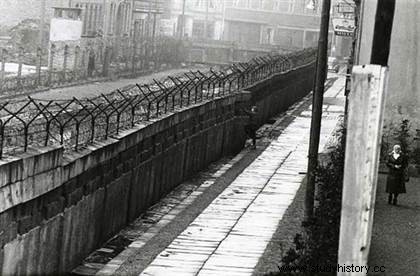 Built in August 1961, the Berlin Wall is the most symbolic evocation of the Cold War . 45 km long, bristling with barbed wire and guarded by many watchtowers, it was above all intended to prevent the East Germans from fleeing the communist regime. Between 1961 and 1989, at least seventy people died trying to "pass the wall", on foot, in ram-cars, by air... The fall of the wall on the night of November 9 to 10, 1989 causes a wave of enthusiasm and hope in the world and especially in Germany, which can finally hope for a reunification expected since the end of the Second World War.
Built in August 1961, the Berlin Wall is the most symbolic evocation of the Cold War . 45 km long, bristling with barbed wire and guarded by many watchtowers, it was above all intended to prevent the East Germans from fleeing the communist regime. Between 1961 and 1989, at least seventy people died trying to "pass the wall", on foot, in ram-cars, by air... The fall of the wall on the night of November 9 to 10, 1989 causes a wave of enthusiasm and hope in the world and especially in Germany, which can finally hope for a reunification expected since the end of the Second World War.
The Iron Curtain and the Cold War
After the capitulation of May 8, 1945, symbol of the ideological victory of democracy over fascism and Nazism, Berlin was occupied and divided into four occupation zones:United States, Great Britain and France controlled the west of Berlin, while the USSR controlled the east of the city. Peace returned to Europe, a divide appears in Europe between the East occupied by the Soviets, and the West close to the United States. A situation denounced in 1946 by Churchill, who evokes an "iron curtain" that fell in Europe. An antagonism that reaches its climax in Germany and in its capital.
In 1949, the FRG (Federal Republic of Germany) was created in the West and the East was controlled by the USSR marked by the creation of the GDR (Republic German Democratic). This date marked the split between two Germanys, the result of the Cold War. Berlin therefore became an enclave within the GDR itself and between 1949 and 1961, the problem arose of the massive flight of its workforce to the western zone with three million citizens of East Germany. 'East passing to the West. It is in this context that the construction of the Berlin Wall is taking shape.
Why the construction of the Berlin Wall?
In a context of "peaceful coexistence", tensions persist and the construction of the Berlin Wall is an integral part of this. On the night of August 12 to 13, 1961, the Soviets decided, to stop the mechanism of exodus, to erect a wall between East Berlin and West Berlin and to mass troops at the border posts. The exodus was considered a real haemorrhage for the Soviet zone. The construction of the wall is therefore conceived in an anti-migration logic of an economic and ideological nature. It was reinforced gradually through several phases, in 1961, it consists mainly of barbed wire with in some places brick walls surmounted by barbed wire. Only seven ultra-secure crossing points remain.
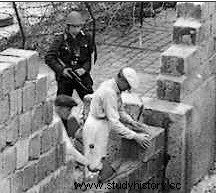 In 1962, the wall was extended 15 km long:barricades were erected over 130 km, 165 watchtowers and 232 blockhouses guard the borders. In 1976, this 3.60 m high wall was preceded by a 40 m wide zone at 1.5 km, which meant that the East Germans could not approach the wall. And in 1989, the eastern authorities prepared the high-tech wall by integrating an electronic surveillance system. However, the people of the East will decide otherwise.
In 1962, the wall was extended 15 km long:barricades were erected over 130 km, 165 watchtowers and 232 blockhouses guard the borders. In 1976, this 3.60 m high wall was preceded by a 40 m wide zone at 1.5 km, which meant that the East Germans could not approach the wall. And in 1989, the eastern authorities prepared the high-tech wall by integrating an electronic surveillance system. However, the people of the East will decide otherwise.
A symbol of injustice
In the West, the construction of the wall caused very little reaction, at a time when tension between Americans and Soviets was at its height. On June 27, 1963, US President John F. Kennedy traveled to West Berlin. He goes to the Berlin Wall in the company of the very popular Social Democrat, Willy Brandt, future Chancellor and Nobel Peace Prize winner. He then gives a speech in which he declares in German:"Ich bin ein Berliner", "I am a Berliner". A quote, which has remained famous, which lets the Soviets and the rest of the world know that the United States will not abandon the divided city.
As for the German population, divided, The Berlin Wall quickly becomes a wall of hatred, the wall of poison that is communism in the minds of the Berliners of the East, and capitalism, in the minds of West Berliners. Everyone sees in his block an undeniable common defect:the deprivation of freedom, the disappearance of choice. And the wall reminds Berliners day after day, but also Germans, of the daily malaise in which they are immersed. Much more than a city, it is a country which is cut in two. The wall is a prison, it is the concrete reflection of the punishment inflicted on the Germans who followed Hitler, and even for those who did not follow him.
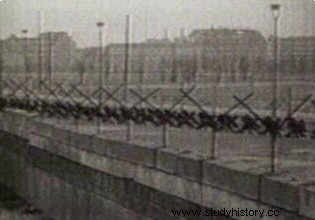 The injustice that the wall represents stirs up the deepest tensions, daily reminders of separation and defeat, it quickly becomes the engine of hope and freedom. If the wall falls, the separation disappears with it. As the storming of the Bastille was the ultimate symbol of the fall of royal power for the French, the Berlin Wall was the last link in the chain to be destroyed when the country regained independence. The wall and the spirit of its construction, made "behind the back" of the East Germans raises the question of the feelings of these populations faced with a situation where they were both actors and spectators.
The injustice that the wall represents stirs up the deepest tensions, daily reminders of separation and defeat, it quickly becomes the engine of hope and freedom. If the wall falls, the separation disappears with it. As the storming of the Bastille was the ultimate symbol of the fall of royal power for the French, the Berlin Wall was the last link in the chain to be destroyed when the country regained independence. The wall and the spirit of its construction, made "behind the back" of the East Germans raises the question of the feelings of these populations faced with a situation where they were both actors and spectators.
The “wall of shame”
But even more, the construction of the wall and the events attached to it will offend public opinion without these events coming to an end. We speak of the "wall of shame" for a very specific reason, that of the attempts to cross the Berlin Wall which will cost the lives of 80 people, of whom 59 were killed by the "vopos" (border guards) and 115 others will be wounded by bullets.
It is estimated that just under 5,000 people managed to cross from East to West Berlin. Throughout the decade of the 1960s, the situation remained frozen and it was not until the beginning of the 1970s, and the coming to power of the Social Democrats led by Willy Brant, to witness the establishment of a Ostpolitik, which constitutes a policy of openness and relaxation with communist Europe and with the USSR.
1989, the iron curtain cracks
Since the beginning of 1989, a wind of change breath on Eastern Europe, against a backdrop of glasnost and perestroika from Moscow. Several countries of the communist bloc saw the establishment of governments inspired by the example of Gorbachev, which began more or less timidly a policy of liberalization. With the exception of Romania and East Germany, where the old Stalinist leaders, clinging to their power and privileges, refute any idea of reforming a dying system.
 Taking advantage of the cracks that split the future former communist bloc, tens of thousands of East Germans, in a long procession of "trabants", trying to pass to the west via Hungary and Czechoslovakia, which have already opened their borders. Inside the country, the protest is swelling and getting organised. In Leipzig in October 1989, demonstrators openly defy the regime in place, from a church which becomes the symbol of the struggle for freedom. For the 40
th
festivities anniversary of the GDR, the Germans parade in front of a pale Erick Honecker and an embarrassed Mikhail Gorbachev shouting "Gorby, Gorby!" Gorby help us! .
Taking advantage of the cracks that split the future former communist bloc, tens of thousands of East Germans, in a long procession of "trabants", trying to pass to the west via Hungary and Czechoslovakia, which have already opened their borders. Inside the country, the protest is swelling and getting organised. In Leipzig in October 1989, demonstrators openly defy the regime in place, from a church which becomes the symbol of the struggle for freedom. For the 40
th
festivities anniversary of the GDR, the Germans parade in front of a pale Erick Honecker and an embarrassed Mikhail Gorbachev shouting "Gorby, Gorby!" Gorby help us! .
A dying East German regime
The Soviet leader tries in vain to convince Honecker of the need for reform, but nevertheless firmly indicates to him that armed repression is, whatever happens, to be excluded. On October 18, Honecker was dismissed from all his functions at the head of the country by the reformers of the Communist Party, including Egon Krenz and Victor Schabowski, officially for "health reasons". But the time is no longer for the reform of a system that is out of breath. Taking to the streets massively this time, East Germans demand free elections and pluralists and the freedom to come and go wherever they please.
Yielding to popular pressure, the East German government is considering loosening up on freedom of movement. In a rush, new travel regulations was announced on November 9 in the early evening by the government spokesperson, during a famous press conference. Victor Schabowski reads a press release which stipulates that "private trips abroad may be authorized without presentation of supporting documents, reason for the trip or family ties". In response to a question from an incredulous journalist, he even adds that this regulation comes into force immediately, although nothing has yet been planned in this direction.
The fall of the Berlin Wall
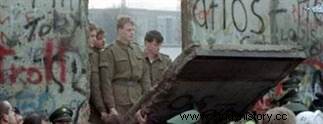 The announcement is like a bomb. The East Germans, who learned of this information on television, must have been many to pinch themselves that evening, and headed to the border posts to check for themselves if they were not dreaming. After a moment of hesitation, the border guards, who have received no instructions, have no choice but to raise the barriers in front of this uninterrupted stream of curious people. In general jubilation and a chorus of car horns, Berliners on both sides celebrate a reunion they dared not hope for a long time.
The announcement is like a bomb. The East Germans, who learned of this information on television, must have been many to pinch themselves that evening, and headed to the border posts to check for themselves if they were not dreaming. After a moment of hesitation, the border guards, who have received no instructions, have no choice but to raise the barriers in front of this uninterrupted stream of curious people. In general jubilation and a chorus of car horns, Berliners on both sides celebrate a reunion they dared not hope for a long time.
The decaying East German government is briefly tempted to take control of the situation. The police and the army politely make them understand that they are incapable of it, however tempted they may have felt like it. Overwhelmed and faced with a fait accompli, he has no other choice but to let it go. History is on the move, and nothing can stop it. Clinging to their TVs, viewers from all over the world watched with emotion at this extraordinary event which sealed the reunion of the German people.
This "wall of shame" in which the East Berliners give the first blows of the pickaxe becomes a symbol of hope, regained freedom and peace. For those who attend Rostropovitch's improvised concert in amazement in front of a piece of the Berlin Wall covered with graffiti and in the process of destruction, only one thing is certain. After that crazy night of November 9, 1989, nothing will be the same.
On December 22, 1989, the official opening of the Brandenburg Gate restores free passage between the two Germanys and underlines the extraordinary liberation that has just taken place around the wall, this symbol of the division of Germany, whose fall was the prelude to the collapse of the communist regime in the GDR and to reunification.
Another world?
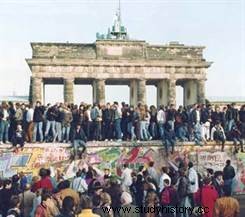 With the fall of the Berlin Wall, it is a world order inherited from the Second World War and which seemed frozen for eternity which is collapsing. It is the end of a Europe and a country cut in two. Germany very quickly undertook its reunification under the impetus of the government of Helmut Kohl, despite the reluctance of Magaret Thatcher and François Mitterrand, taking advantage of the euphoria of the moment and the passivity of the Soviet Union. With the fall of the wall, a system exploded and a democratic transition began, peacefully as in Czechoslovakia, more violently as in Romania, incompletely in Russia. This falling wall means new challenges for Europe and the world.
With the fall of the Berlin Wall, it is a world order inherited from the Second World War and which seemed frozen for eternity which is collapsing. It is the end of a Europe and a country cut in two. Germany very quickly undertook its reunification under the impetus of the government of Helmut Kohl, despite the reluctance of Magaret Thatcher and François Mitterrand, taking advantage of the euphoria of the moment and the passivity of the Soviet Union. With the fall of the wall, a system exploded and a democratic transition began, peacefully as in Czechoslovakia, more violently as in Romania, incompletely in Russia. This falling wall means new challenges for Europe and the world.
Germany celebrated and commemorated in 2014 the 25th anniversary of the fall of the Berlin Wall which marked the end of an era, that of the Cold War but more , that of the possible reunification of Germany which had been abandoned after the Second World War. This desire for unification has never ceased to animate the Berlin population, which opens the door to the unification of Germany divided between the FRG and the GDR which took place in 1990.
To remember this period of history, pieces of walls have also been donated to many cities around the world:Paris, Montreal, Buenos Aires... The side that was located to the east is usually white or containing very few inscriptions, as it was guarded and protected by barbed wire. The side that was to the west is on the contrary colorful with tags, drawings and inscriptions calling for freedom. Even more than his belonging to German history, he is today presented as the symbol of freedom against oppression throughout the whole world.
Bibliography
- By Daniel Venert, November 1989, The Berlin Wall Crumbles, Seuil.
- By Alexandre Adler, Berlin November 9, 1989:the fall. Xo Editions, 2009.
- By Michel Meyer, Secret History of the Fall of the Berlin Wall. Editions Odile Jacob, 2009.
